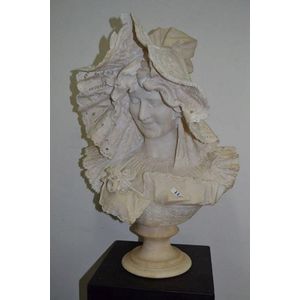Belleek Fish Spill Vase with Pearl Lustre Finish
A novelty Belleek fish spill vase, 1863-1890, first black mark period and registration pad, an upright open-mouthed fish rising out of the waves, with fine scales in relief and a magnificent set of fins, with a pearl lustre finish to the head, fins and base; printed mark underside and applied pad, height 19 cm
You must be a subscriber, and be logged in to view price and dealer details.
Subscribe Now to view actual auction price for this item
When you subscribe, you have the option of setting the currency in which to display prices to $Au, $US, $NZ or Stg.
This item has been sold, and the description, image and price are for reference purposes only.
- Spill Vase - Popular in Victorian times, a spill vase was a vessel for holding thin slips of wood or spills of paper with which to light a candle or pipe from a fire. For ease of access to the fire, they usually sat on the mantlepiece or had a hole in the back, so they could be hung from a wall. Their use declined with the with the evolution of heating through use of electricity and the use of safety matches in the late 19th century.
- Lustre Ware - Lustre decoration on ceramics is created by painting a thin deposit of metal oxide such as gold, silver or copper onto the surface, and then firing the item again, so that metal oxide forms a thin film on the surface. The finished effect is a shiny metallic surface. The technique was used in the 19th century by potteries such as Crown Devon, Grimwades, Maling, and Royal Doulton. However the best known use was by Wedgwood for its Fairyland lustre.
This item has been included into following indexes:
- Belleek (Ireland), items
Visually similar items

Antique alabaster bust of a young lady, wearing a lace bonnet, mounted on a turned sockle, approx 63 cm high
Sold by
in
for
You can display prices in $Au, $US, $NZ or Stg.

White jade figure of Quan Yin. Height 26.5 cm
Sold by
in
for
You can display prices in $Au, $US, $NZ or Stg.

Antique French alabaster bust, approx 65 cm high
Sold by
in
for
You can display prices in $Au, $US, $NZ or Stg.

A carved alabaster statue of Venus de Milo c.1900. Height 49 cm
Sold by
in
for
You can display prices in $Au, $US, $NZ or Stg.
